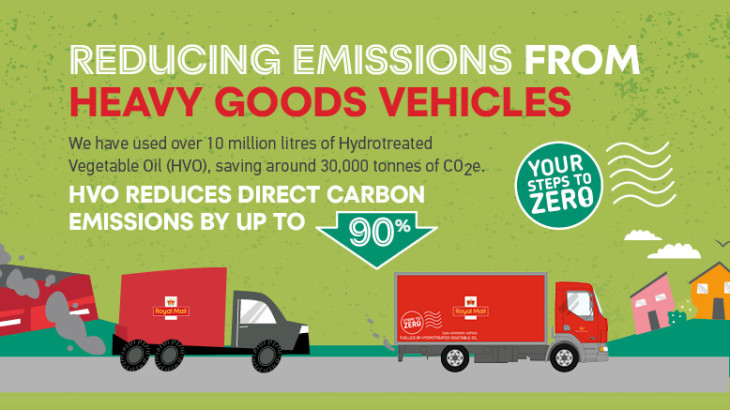Milestone moment

Last year, we rolled-out hydrotreated vegetable oil or ‘HVO’ to our bulk fuel tanks at six locations. This bio-fuel reduces our carbon emissions without costly vehicle or infrastructure works and we’ve recently surpassed using 10 million litres of HVO, overall.
With an up to 90% reduction in direct carbon emissions compared to diesel, this increased deployment of HVO is a welcome step towards achieving our Net-Zero by 2040 target, and helping our customers achieve their environmental goals.
Zebrina Hanly, Royal Mail’s Head of Environment, said: “It’s important to us and to our customers that we do everything we can to reduce our emissions as soon as possible. Electric and hydrogen options for HGVs are still in their infancy, so whilst the technology and infrastructure are developing, our strategy is to keep emissions to a minimum by using HVO as a transitional fuel.”
Deploying over 10 million litres of HVO results in a saving of around 30,000 tonnes of CO2e, that’s carbon dioxide and equivalent gases, in direct emissions compared to diesel.
We work closely with suppliers to ensure the HVO we procure is derived from residual waste or other sustainable feedstocks. We purchase only ISCC certified HVO that has Proof of Sustainability (PoS) certification demonstrating a fully validated and auditable supply chain.
Looking ahead, we will continue to use HVO at six of our largest sites, including both parcel hubs in Daventry and Warrington and key sites in the East Midlands, Manchester, Sheffield and Warrington and plan to deploy HVO to an additional site in the coming year.
We anticipate deploying an additional 17 million litres this year, bringing the total annual volume to 27 million litres, and will update you on the new HVO site in the coming weeks.
HVO FREQUENTLY ASKED QUESTIONS
1. Can HVO be used in all vehicle types?
All diesel engine vehicles can refuel using HVO.
2. Do drivers need to do anything different when refuelling vehicles?
No, the refuelling process remains the same and fuel pumps will operate the same.
3. Can Euro 4 & Euro 5 vehicles be taken into Clean Air Zones when running on HVO?
No, unfortunately not. Only Euro 6 vehicles can enter the Clean Air Zones
4. What will happen to the diesel that currently sits in the bulk fuel tank?
The Fuel Team Manager is running stocks down to a safe level and the remaining fuel will be destroyed in line with government legislation.
5. Can you mix HVO and diesel?
Yes, HVO and diesel can be mixed.
6. Where does HVO come from?
HVO is manufactured in a number of refineries around the world. The fuel is entirely made from waste materials such as used cooking oils, tallows and other waste oil or renewable feedstocks. The HVO fuel we use is made predominantly of used cooking oil and does not include any virgin crops. The HVO product we procure must also be ISCC-certified with a Proof of Sustainability (PoS), verification that it has a fully validated and auditable supply chain
7. Does HVO contain palm oil?
Some HVO manufactured around the world may contain palm oil however we work closely with our suppliers to ensure that any HVO fuel we procure is not derived from palm oil and will continue to do so.
8. What are the benefits of HVO?
-
Up to 90% reduction in carbon emissions.
-
Fleets have reported a reduction in the consumption of Adblue.
-
HVO is a cleaner fuel therefore fleets experience a reduction diesel particulate filter issues as the fuel leaves no carbon deposits and in fact has a cleaning effect on engines.
-
HVO is also odourless and biodegradable.



